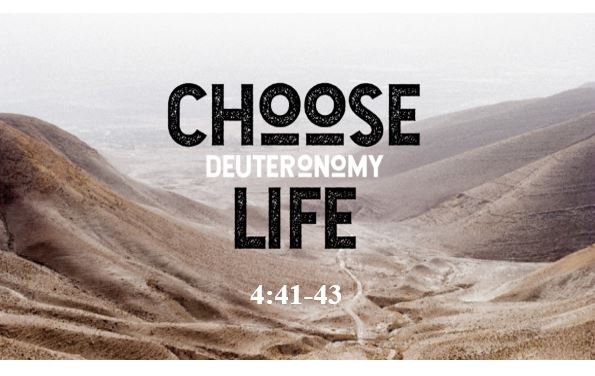BIG IDEA:
MOSES IMPLEMENTS A LEGAL SYSTEM IN THE NEWLY ACQUIRED TRANSJORDANIAN TERRITORY THAT COMBINES MERCY AND JUSTICE
INTRODUCTION:
Duane Christensen: The reader cannot help but feel the jarring effect of encountering a totally different type of content as one moves from v 40 to v 41. A narrator suddenly appears, without introduction, to describe the establishment of three cities of refuge for the tribes in Transjordan.
Peter Craigie: These verses, which are not a part of the address of Moses, describe an action undertaken between the preliminary address (the Historical Prologue) and the subsequent address in which the Law is presented and expounded. They describe the allocation of three eastern cities of refuge, and the appointment of them at this point in the course of the narrative seems suitable. The historical prologue had described the experiences of the Israelites up to the present moment on the plains of Moab; that part of the address which follows has its specific focus on the future. Yet there was one bit of unfinished business relating to the past, the setting aside of cities of refuge for the two and a half tribes who had already been allocated land east of the Jordan.
Michael Grisanti: Moses addresses this issue here (an interlude of sorts) because these cities are likely chosen for this function at this time (while Israel is camped in the plains of Moab). The conquest of Transjordan has been accomplished, and there is no need to delay the fulfillment of the divine requirement for these locations (cf. Nu 35).
Brian Bell: This is an appropriate place for this list, as his 1st sermon dealt with the conquest & settlement of Transjordan by Israel. Joshua will designate 3 more cities of refuge in the land of Canaan (totaling 6). By providing cities of refuge God showed Himself to be both gracious & just.
Holman Bible Dictionary: A safe place to flee for a person who had accidentally killed another. The city provided asylum to the fugitive by sheltering and protecting him until a trial could be held to determine his guilt or innocence. If, in the judgment of the city elders, the death had occurred accidentally and without intent, the man was allowed to stay there without fear of harm or revenge by the dead man’s relatives (Joshua 20:2-6).
I. (:41) DESIGNATION OF THE TRANSJORDANIAN CITIES OF REFUGE
A. Designated Cities
“Then Moses set apart three cities”
B. Designated Territory
“across the Jordan to the east,”
II. (:42) PURPOSE OF THE TRANSJORDANIAN CITIES OF REFUGE
A. Destination for a Manslayer
“that a manslayer might flee there,”
B. Definition of a Manslayer
“who unintentionally slew his neighbor
without having enmity toward him in time past;”
C. Destiny of a Manslayer
“and by fleeing to one of these cities he might live:”
David Thompson: Moses really develops this idea in Deuteronomy 19:2-13. Sometimes accidents do happen and sometimes someone dies because of an accident. The illustration given in Deuteronomy 19 is that a man went into the woods to cut wood and the iron head of the axe flew off and hit his friend and he dies. This certainly was not an intentional homicide. It was an accident. These cities were provided by God as a place of refuge for the person who did it.
A family member avenger of blood had a right to track down the person and even the score. These cities prevented him from killing one who was innocent.
III. (:43) LOCATION OF THE TRANSJORDANIAN CITIES OF REFUGE
A. Bezer
“Bezer in the wilderness on the plateau for the Reubenites,”
Eugene Merrill: If Bezer is the same as Bozrah (Umm el-‘Amad) as some scholars maintain, the place in view was some six miles east of Heshbon, well within the territory that had already been assigned to the tribe of Reuben (cf. 3:16-17).
B. Ramoth
“and Ramoth in Gilead for the Gadites,”
Eugene Merrill: The second city is the well known “Ramoth in Gilead” (modern Tell Ramith) so named as to distinguish it from other places with the same name. It lay some thirty-five miles east of the Jordan River and southeast of the Sea of Galilee, high up in the Gilead plateau. It was conveniently located for the Gadites who had settled there.
Bruce Hurt: Ramoth was a celebrated city in the mountains of Gilead, placed by Eusebius fifteen miles east from Philadelphia or Ammon, and by Jerome in the neighbourhood of Jabbok, and consequently north of Philadelphia. (Jos 21:38; 1Ki 4:13; 22:3, 4; 1Ch 6:80)
C. Golan
“and Golan in Bashan for the Manassites.”
Eugene Merrill: It was only forty miles north of Ramoth-Gilead and about the same distance due east of the Sea of Galilee.
Bruce Hurt: This city gave name to the district of Gaulonitis, now called Djolan, which comprises the plain to south of Djedour or Iturea, and to the west of Haouran: its southern frontier is the Nahar Aweired, by which it is separated from the district of Erbad, and the Sheriat el Mandhour, which separates it from the district of El Kefarat: on the west it is limited by the territory of Feik, and on the north-west by Djebel Heish, or mount Hermon. (Jos 21:27; 1Ch 6:71)

